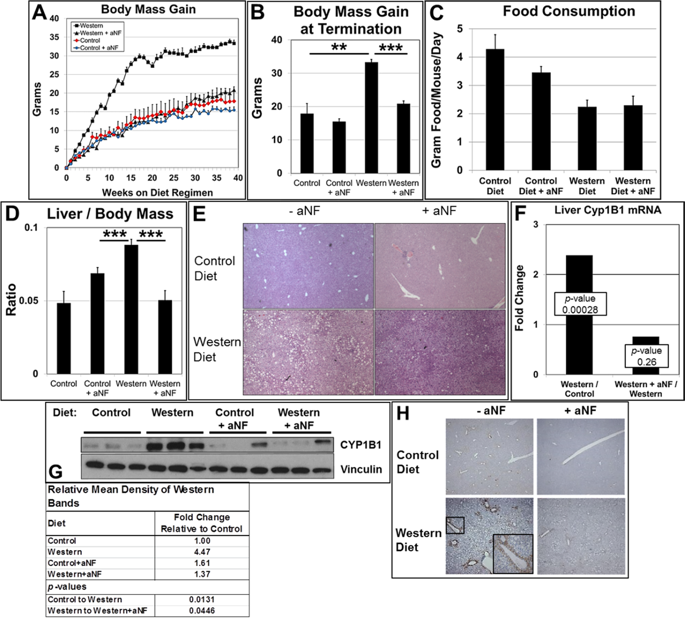International Journal of Obesity ( IF 4.2 ) Pub Date : 2020-01-07 , DOI: 10.1038/s41366-019-0512-z Itzel Y Rojas 1, 2 , Benjamin J Moyer 1 , Carol S Ringelberg 1 , Craig R Tomlinson 1, 3

|
Background/objectives
Obesity is a global epidemic and the underlying basis for numerous comorbidities. We report that the aryl hydrocarbon receptor (AHR) plays a key role in the metabolism of obesity. The AHR is a promiscuous, ligand-activated nuclear receptor primarily known for regulating genes involved in xenobiotic metabolism and T cell polarization. The aims of the work reported here were to understand the underlying mechanism of AHR-based obesity and to determine whether inhibition of AHR activity would reverse obesity.
Methods
Mice were fed control (low fat) and Western (high fat) diets with and without the AHR antagonist alpha-naphthoflavone (aNF). Gene expression of identified AHR-regulated genes from liver and adipose tissue was characterized. To determine the role of the AHR in obesity reversal, selected mice in control and Western diet regimens were switched at midpoint to the respective control and Western diets containing aNF, and the identified AHR-regulated genes characterized.
Results
AHR inhibition prevented obesity in mice on a 40-week diet regimen. The likely AHR-regulated and cross-regulated downstream effectors of AHR-based obesity were shown to be CYP1B1, PPARα-target genes, SCD1, and SPP1 (osteopontin). Western diet caused an increase of mRNA and protein expression of the Cyp1b1, Scd1, and Spp1, and PPARα-target genes in the liver, and inhibition of the AHR maintained expression of these genes near control levels. The body weight of obese mice on Western diet switched to Western diet containing aNF decreased to that of mice on control diet concurrently with a reduction in the expression of liver CYP1B1, PPARα-target genes, SCD1, and SPP1. AHR inhibition prevented hypertrophy and hyperplasia in visceral adipose tissue and limited expression levels of CYP1B1 and SPP1 to that of mice on control diet.
Conclusions
AHR inhibition prevents and reverses obesity by likely reducing liver expression of the Cyp1b1, Scd1, Spp1, and PPARα-target genes; and the AHR is a potentially potent therapeutic target for the treatment and prevention of obesity and linked diseases.
中文翻译:

通过抑制芳烃受体并改变 CYP1B1、PPARα、SCD1 和骨桥蛋白的基因表达来逆转小鼠肥胖和肝脏脂肪变性
背景/目标
肥胖是一种全球流行病,也是许多合并症的根本原因。我们报告芳烃受体(AHR)在肥胖代谢中发挥关键作用。 AHR 是一种混杂的配体激活核受体,主要以调节参与外源代谢和 T 细胞极化的基因而闻名。本文报告的工作目的是了解基于 AHR 的肥胖的潜在机制,并确定抑制 AHR 活性是否会逆转肥胖。
方法
给小鼠喂食对照(低脂肪)和西方(高脂肪)饮食,含或不含 AHR 拮抗剂 α-萘黄酮 (aNF)。对肝脏和脂肪组织中已鉴定的 AHR 调节基因的基因表达进行了表征。为了确定 AHR 在肥胖逆转中的作用,将对照组和西方饮食方案中选定的小鼠在中点转换为各自的对照组和含有 aNF 的西方饮食,并对已识别的 AHR 调节基因进行表征。
结果
AHR 抑制可预防采用 40 周饮食方案的小鼠肥胖。基于 AHR 的肥胖可能受 AHR 调节和交叉调节的下游效应器被证明是 CYP1B1、PPARα 靶基因、SCD1 和 SPP1(骨桥蛋白)。西方饮食导致肝脏中Cyp1b1、Scd1 和 Spp1以及 PPARα 靶基因的 mRNA 和蛋白质表达增加,并且 AHR 的抑制使这些基因的表达维持在接近对照水平。接受西方饮食的肥胖小鼠改用含有aNF的西方饮食后,其体重下降至对照饮食小鼠的体重,同时肝脏CYP1B1、PPARα靶基因、SCD1和SPP1的表达减少。 AHR 抑制可防止内脏脂肪组织肥大和增生,并将 CYP1B1 和 SPP1 的表达水平限制为对照饮食的小鼠。
结论
AHR 抑制可能通过减少Cyp1b1、Scd1、Spp1和 PPARα 靶基因的肝脏表达来预防和逆转肥胖; AHR 是治疗和预防肥胖及相关疾病的潜在有效治疗靶点。











































 京公网安备 11010802027423号
京公网安备 11010802027423号